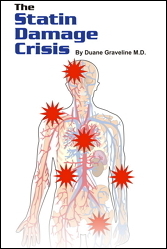Statins, PLS, ALS and PN

by Duane Graveline, MD, MPH
After my two experiences of transient global amnesia from taking a statin, I naturally stopped taking the drug and thought that would be the end of it. At the time, I had no idea that the damage done from the statin would be so disabling, progressive and permanent.
This has led me on a long and difficult path from suspected primary lateral sclerosis (PLS) to amyotrophic lateral sclerosis (ALS) then to peripheral neuropathy (PN).
The initial symptoms of ALS can vary widely from person to person. For example, one person may have trouble grasping an object while another may have initial trouble with swallowing.
My initial onset was characterized by weakness, loss of balance and pain. Only the use of strong narcotics permitted me more or less normal daily function. Soon the loss of balance required the use of a cane and a walker.
My weakness was such that I no longer could mow my lawn or work in my garden or wheel my wheelbarrow. One of my early unusual symptoms was the aspiration of a pecan half in a salad my wife had prepared. After a normal lifetime of swallowing, having to be hospitalized for removal of the offending nut from my bronchial tube was a novel experience, which when added to my progressive muscular weakness was very suggestive.
My voice was different and now lacked the quality that helped make me an effective speaker. Some six years ago I had to give up public speaking, partly because of this change in speaking character.
I no longer walked with normal balance. On seeing me walk by her home a friendly neighbor asked, “Dr. Graveine, could I give you a ride home?” To her I must have looked somewhat disabled or even intoxicated; this was my first indication of public awareness of change in my walking character.
My rate of decline was slow, requiring nearly six years of using a cane and a walker and ultimately an electric scooter which made me think I was dealing with primary lateral sclerosis.
The only thing missing was the muscle atrophy which arrived one year ago when I experienced a 20 pound weight loss, going from 188 lbs. to 168 lbs., my present weight.
I noticed obvious atrophy of my calf and forearm muscles, strongly suggesting to me the evolution of my degenerative condition from primary lateral sclerosis (PLS) to ALS. Yet a muscle biopsy six months ago showed an unequivocal diagnosis of denervation atrophy of muscle fibers, which with studies of muscle reaction and nerves to electrical stimulation showed peripheral neuropathy (PN).
This demanded that I re-evaluate the unusual symptoms involving blood pressure that I had noted leading to initiation of blood pressure medicine for what proved to be a highly variable condition, with frequent adjustment of medication required for recurring tendency for postural hypotension.
Clearly my autonomic nervous system seemed involved, further supporting the peripheral neuropathy diagnosis. It appears that my pain, muscle weakness and loss of balance while walking is secondary to nerve damage. My neurologist said my atrophy was lack of exercise and age.
Clearly, in retrospect, I should have asked that appropriate studies be done much earlier. A creatine phosphokinase (CPK) test should have been done early on because of the pain. Then muscle biopsy was indicated along with electrical stimulation of nerves and muscles early on in the process, not after waiting an entire decade.
I am personally convinced that this inexpensive test battery would diagnose 95% of the common conditions, leaving auto-immune which is important mostly because it is the only adverse condition that is treatable.
With respect to treatment, if CPK is elevated, you should talk with your doctor about stopping the statin or, if high risk, ask about dramatically reducing the dose.
Only in high risk cases (ignoring the cholesterol) would I consider a statin appropriate and then it would be at a low dose. Remember that cholesterol is irrelevant for most people in cardiovascular disease. Generally speaking, the higher your cholesterol the healthier, wiser and longer lived you are.
Only genetically preordained cases require targeting cholesterol. There are fewer than 2% of all cases in this category with cholesterol levels commonly 400-600 or higher often with the presence of xanthomas (wax-like deposits in the skin, usually present on eyelids, elbows or knees).
Statin associated myopathy like neuropathy is typically very resistant and most cases prove to defy all treatment and can be regarded as permanent. Rarely does the simple expedient of stopping the statins work either for myopathy or neuropathy.
Duane Graveline MD MPH
Former USAF Flight Surgeon
Former NASA Astronaut
Retired Family Doctor
Updated May 2016






